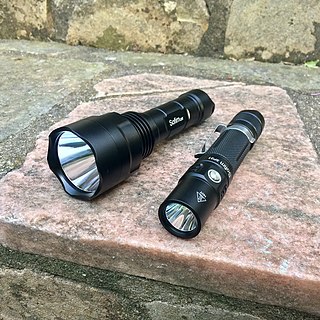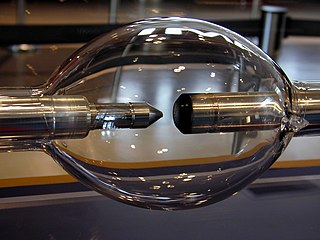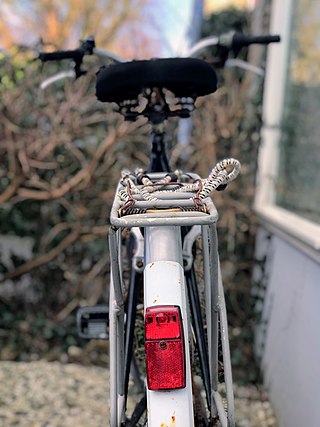
Carl Zeiss AG, branded as ZEISS, is a German manufacturer of optical systems and optoelectronics, founded in Jena, Germany in 1846 by optician Carl Zeiss. Together with Ernst Abbe and Otto Schott he laid the foundation for today's multinational company. The current company emerged from a reunification of Carl Zeiss companies in East and West Germany with a consolidation phase in the 1990s. ZEISS is active in four business segments with approximately equal revenue in almost 50 countries, has 30 production sites and around 25 development sites worldwide.

A flashlight or electric torch, usually shortened to torch, is a portable hand-held electric lamp. Formerly, the light source typically was a miniature incandescent light bulb, but these have been displaced by light-emitting diodes (LEDs) since the early 2000s. A typical flashlight consists of the light source mounted in a reflector, a transparent cover to protect the light source and reflector, a battery, and a switch, all enclosed in a case.

A headlamp is a lamp attached to the front of a vehicle to illuminate the road ahead. Headlamps are also often called headlights, but in the most precise usage, headlamp is the term for the device itself and headlight is the term for the beam of light produced and distributed by the device.

Leatherman is an American brand of multi-tool made by Leatherman Tool Group of Portland, Oregon. The company was founded in July 1983 by Timothy S. Leatherman and Steve Berliner in order to market the former's idea of a capable, easily portable hand tool with multiple functions. That same year, Leatherman Tool Group sold its first Multi-Tool, which was called the PST.

Maglite is a brand of flashlight manufactured in the United States by Mag Instrument, Inc. located in Ontario, California, and founded by Anthony Maglica. It was introduced in 1979. Constructed principally of anodized 6061 aluminum, they have a variable-focus beam. Maglites are produced in several colors such as black, silver, blue, red, green, purple, gold, and different finishes. Originally Maglite flashlights used krypton or xenon incandescent bulbs. Current models have LEDs, although the older models are still widely available.

Allgemeine Elektricitäts-Gesellschaft AG was a German producer of electrical equipment. It was founded in 1883 by Emil Rathenau as the Deutsche Edison-Gesellschaft für angewandte Elektricität in Berlin.

High-intensity discharge lamps are a type of electrical gas-discharge lamp which produces light by means of an electric arc between tungsten electrodes housed inside a translucent or transparent fused quartz or fused alumina arc tube. This tube is filled with noble gas and often also contains suitable metal or metal salts. The noble gas enables the arc's initial strike. Once the arc is started, it heats and evaporates the metallic admixture. Its presence in the arc plasma greatly increases the intensity of visible light produced by the arc for a given power input, as the metals have many emission spectral lines in the visible part of the spectrum. High-intensity discharge lamps are a type of arc lamp.

Bicycle lighting is illumination attached to bicycles whose purpose above all is, along with reflectors, to improve the visibility of the bicycle and its rider to other road users under circumstances of poor ambient illumination. A secondary purpose is to illuminate reflective materials such as cat's eyes and traffic signs. A third purpose may be to illuminate the roadway so that the rider can see the way ahead. Serving the latter purposes require much more luminous flux and thus more power.

Rollei was a German manufacturer of optical instruments founded in 1920 by Paul Franke and Reinhold Heidecke in Braunschweig, Lower Saxony, and maker of the Rolleiflex and Rolleicord series of cameras. Later products included specialty and nostalgic type films for the photo hobbyist market.

SureFire, LLC. is an American company headquartered in Fountain Valley, California. Their main products are flashlights, weapon-mounted lights, headlamps, and laser sights. In addition, Surefire produces knives, sound suppressors, earplugs, Picatinny Rails, magazines, and batteries. The company is a major supplier of flashlights, weapon lights, and lasers to the U.S. Armed Forces and its allies, especially for elite special operations groups such as the Navy SEALs. Surefire products are widely used in the U.S. by law enforcement agencies and SWAT teams.

Rodenstock GmbH is a German manufacturer of ophthalmic lenses and frames for eyeglasses. The company, which was founded by Thuringian Josef Rodenstock in 1877, is headquartered in Munich.
ams OSRAM AG, formerly known as Austria Microsystems AG and ams AG, is an Austrian electronics company that designs and manufactures sensors for small form factor, low power, highest sensitivity and multi-sensor applications. Products include sensors, sensor ICs, interfaces and related software for mobile, consumer, communications, industrial, medical, and automotive markets.

A bayonet mount or bayonet connector is a fastening mechanism consisting of a cylindrical male side with one or more radial pins, and a female receptor with matching L-shaped slot(s) and with spring(s) to keep the two parts locked together. The slots are shaped like a capital letter L with serif ; the pin slides into the vertical arm of the L, rotates across the horizontal arm, then is pushed slightly upwards into the short vertical "serif" by the spring; the connector is no longer free to rotate unless pushed down against the spring until the pin is out of the "serif".

Osram Opto Semiconductors GmbH of Regensburg, Germany, was a wholly owned subsidiary of Osram GmbH, which was the world's second largest manufacturer of optoelectronic semiconductors after Nichia and followed in third place by Cree Inc. The company was founded in 1999 as a joint venture between Osram and Infineon Technologies. In 2021 Osram Opto Semiconductors was integrated to AMS-Osram International GmbH and is now part of the AMS Osram Group.
SALTUS Industrial Technique GmbH, or SALTUS, located in Solingen/Germany is a part of the Swedish Atlas Copco Group with main office in Stockholm/Sweden. Saltus is integrated in the Group since 2013 as product company with focus of engineering and production of torque wrenches as well as sockets, bits and special, customized sockets.

A headlamp, headlight, or head torch (UK) is a light source affixed to the head typically for outdoor activities at night or in dark conditions such as caving, orienteering, hiking, skiing, backpacking, camping, mountaineering or mountain biking. Headlamps may also be used in adventure races. Headlamps are often used by workers in underground mining, search and rescue, surgeons, and by other workers who need hands-free directed lighting.
Sylvania Lighting, Havells-Sylvania, and SLI, is an international designer and manufacturer of lighting products, trading as Sylvania. It has plants throughout Europe, Asia, North Africa and Central and South America, and is one of the few lighting companies that produces both lamps and lighting fixtures. It is owned by Shanghai Feilo Acoustics Ltd., having previously been owned by the Indian electrical company Havells.
Böker was one of the first companies to offer ceramic knives as a featured product line.

Zwilling J. A. Henckels AG is a German knife-maker based in Solingen, Germany. It is one of the largest and oldest manufacturers of kitchen knives for domestic and professional use, having been founded in June 1731 by Peter Henckels. It is also one of the oldest operating companies in the world. The brand's namesake was Johann Abraham Henckels (1771–1850), who renamed the brand after himself under his leadership. J. A. Henckels is one of the leading manufacturers of chef's knives. Since 1970, Zwilling is fully owned by Werhahn KG. The following brands belong to the Zwilling Group: ZWILLING, HENCKELS, Miyabi, BSF, Demeyere, Staub, Fontignac, Ballarini, Flammkraft, and Santos Grills.

The Wolves Are Back? is a sculpture exhibition created by German artist Rainer Opolka. The exhibition was created as a response to the growing presence of Pegida in the German city of Dresden. The exhibition was installed in front of the Dresden Frauenkirche in Neumarkt square on March 16, 2016, where it remained until March 23, 2016. The exhibition featured 66 metal wolf sculptures placed around the square. The wolves were anthropomorphic in nature, appearing more human towards the center of the exhibition. The wolf statues were arranged around a central figure, a golden wolf giving the Nazi salute. This figure is thought to represent Pegida's leader at the time, Lutz Bachmann.


















